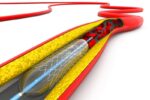Original title: Second Generation Drug-Eluting Stents Implantation Followed by Six Versus Twelve-Month – Dual Antiplatelet Therapy- The SECURITY Randomized Clinical Trial. Reference: Antonio Colombo et al. J Am CollCardiol. 2014 Nov 18;64(20):2086-97. The optimal duration of dual antiplatelet therapy after second-generation DES implantation is still debated and apparently will remain controversial for some time. The aim of this...
Risks and benefits of Dual Antiplatelet beyond the year of a drug-eluting stent
Original title: Twelve or 30 Months of Dual Antiplatelet Therapy after Drug-Eluting Stents. Reference: Laura Mauri et al. N Engl J Med 2014;371:2155-66. Dual antiplatelet therapy is recommended after a drug-eluting stent to prevent thrombotic complications. The clinical benefit of this scheme it is not clear beyond one year. Patients were registered to receive a...
Promising results of TAVR in Bicuspid Aortic
Original title: Transcatheter Aortic Valve Replacement in Bicuspid Aortic Valve Disease. Reference: Darren Mylotte, et al. J Am Coll Cardiol 2014;64:2330-9 The bicuspid aortic valve (BAV) is present between 0.5% and 2% of the general population and up to 20% of patients older than 80 years who require aortic valve surgery. Literature on transcatheter aortic valve...
Hybrid Revascularization in Multiple Vessels
Original title: Hybrid Revascularization for Multivessel Coronary Artery Disease Reference: Mariuz Gassior, et al. J Am Cardiol Intv 2014;7:1277-83 According to the international guidelines, coronary artery bypass grafting (CABG) continues to be the “Gold Standard” treatment for multiple vessels diseases. However, second generation DES and the hybrid strategy may eventually change indications. This study randomized 102...
Thienopyridine Pretreatment in Non ST Elevation ACS syndrome
Original title: Reappraisal of thienopyridine pretreatment in patients with non-ST elevation acute coronary syndrome: a systematic review and meta-analysis. Reference: Bellemain-Appaix A. et al. BMJ. 2014;Epub ahead of print. This meta-analysis included 7 studies that included a total 32383 patients admitted with non ST elevation ACS; 17545 (54.5%) underwent PCI. These studies were published between 2001 and 2013:...
TAVR: Regression of Left Ventricular Hypertrophy Decreases Re-hospitalization
Original title: Early Regression of Severe Left Ventricular Hypertrophy After Transcatheter Aortic Valve Replacement Is Associated with Decreased Hospitalization. Reference: Brian Lindman, et al. JACC Cardiovasc Interv 2014;7:662-73. Left ventricular hypertrophy, defined by the increase of left ventricular mass, has long been associated to increased morbi-mortality in the context of different heart conditions. LV hypertrophy regression might...
Septal ablation, a valid alternative for obstructive hypertrophic cardiomyopathy
Original title: Survival of Patients ≤50 Years Alter Alcohol Septal Ablation for Hypertrofic Obstructive Cardiomyopathy. Reference: Josef Veselka, et al. Canadian Journal of Cardiology 2014,30:634-638 Treatment of symptomatic obstructive hypertrophic cardiomyopathy (HCM) is the surgical septal myomectomy nevertheless, currently arose several studies reporting a favourable evolution and comparable to surgery with septal ablation (AS). 75 patients under 50...
Coronary angioplasty via radial access using 4 Fr introducer. Minimally invasive to the extreme.
Original title: Comparison of frequency of Radial Artery Oclusion Alter 4Fr Versus 6Fr Transradial Coronary intervention (from the Novel Angioplasty Using Coronary Accessor Trial). Reference: Satoshi Takesita, et al. Am J Cardiol 2014;113:1986-89) Since Andreas Gruentzig performed the first angioplasty, technological development has improved devices and radial access becomes more common. This procedure reduces complications, mainly bleeding. However,...
The radial access is a viable alternative in infarction complicated with cardiogenic shock
Original title: Arterial access site utilization in cardiogenic shock in the United Kingdom: Is radial access feasible? Reference: Mamas A. Mamas, et al. Am Heart J 2014;167:900-08 Cardiogenic shock in the context of acute myocardial infarction is associated with high mortality, and represents approximately 10% of major bleeding complications. Radial Access reduces mortality mainly by reducing bleeding; however,...
Increased security with bivalirudin than with heparin alone in patients without ST segment.
Original title: Heparin monotherapy or bivalirudin during percutaneous coronary intervention in patients with non-ST-segment elevation acute coronary syndromes or stable ischemic heart disease: results from the Evaluation of Drug-Eluting Stents and Ischemic Events registry. Reference: Bangalore S et al. CircCardiovascInterv. 2014;Epub ahead of print. Bivalirudin compared to unfractionated heparin as monotherapy is associated with a lower risk of...









